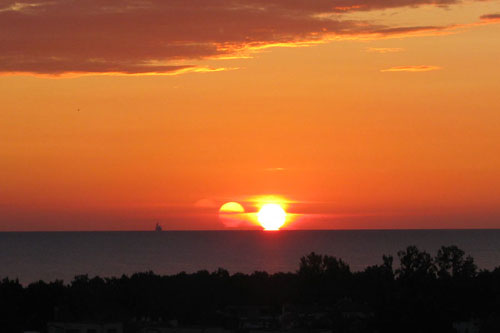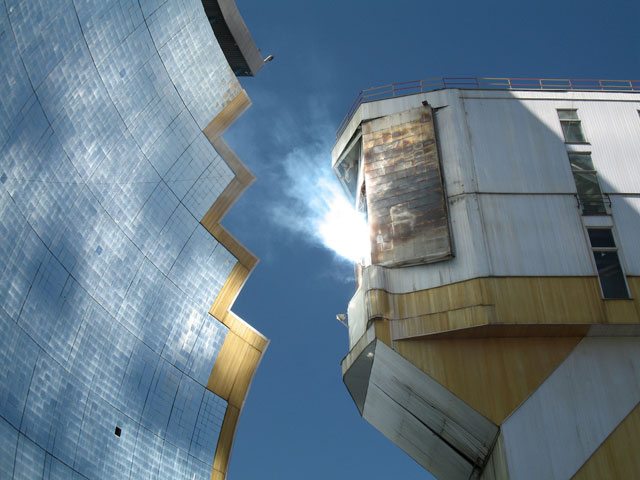During a search for a radioactive isotope-based random number generator, researchers discovered that radioactive decay rates, previously thought to be constant, appear to be influenced by the activity of the Sun.
On Dec 13, 2006, the sun itself provided a crucial clue, when a solar flare sent a stream of particles and radiation toward Earth. Purdue nuclear engineer Jere Jenkins, while measuring the decay rate of manganese-54, a short-lived isotope used in medical diagnostics, noticed that the rate dropped slightly during the flare, a decrease that started about a day and a half before the flare.
If this apparent relationship between flares and decay rates proves true, it could lead to a method of predicting solar flares prior to their occurrence, which could help prevent damage to satellites and electric grids, as well as save the lives of astronauts in space.
The decay-rate aberrations that Jenkins noticed occurred during the middle of the night in Indiana — meaning that something produced by the sun had traveled all the way through the Earth to reach Jenkins’ detectors. What could the flare send forth that could have such an effect?
Jenkins and Fischbach guessed that the culprits in this bit of decay-rate mischief were probably solar neutrinos, the almost massless particles famous for flying at nearly the speed of light through the physical world — humans, rocks, oceans or planets — with virtually no interaction with anything.
Maybe the science part of 2012 wasn’t so far-fetched after all. (No, not really.)
A massive solar flare on September 1, 1859 “caused the most potent disruption of Earth’s ionosphere in recorded history”.
Within hours, telegraph wires in both the United States and Europe spontaneously shorted out, causing numerous fires, while the Northern Lights, solar-induced phenomena more closely associated with regions near Earth’s North Pole, were documented as far south as Rome, Havana and Hawaii, with similar effects at the South Pole.
(via the browser)
In early July, a photographer took a picture of what appears to be three Suns rising over Gdansk Bay in Poland.

The photographer insists that the effect was not created by the camera and was visible to the naked eye. The early consensus in the forums is that the photo was taken through a double-paned window.
The Big Picture collects photos of the Sun. I’ve featured a number of these on kottke.org before but it never hurts to look often at the Sun.
Observe sunspots by going to Grand Central Terminal?
The southern wall of the Grand Concourse, facing 42nd Street, has semicircular grills high up, with small curlicued spaces like those in a leafy tree. Many of those spaces act like the aperture of a pinhole camera, reflecting an image of the sun that, when it reaches the floor, will be 8 to 12 inches wide. The smaller grill spaces will produce dimmer but sharper solar images on your paper.
(via 92y blog)
The One Day Poem Pavilion uses the sun to display a poem one line at a time over the course of an entire day. (via stingy kids)
A solar furnace is a structure used to harness the rays of the sun in order to produce high temperatures. This is achieved by using a curved mirror (or an array of mirrors) acting as a parabolic reflector to concentrate light (Insolation) on to a focal point. The temperature at the focal point may reach up to 3,000 degrees Celsius, and this heat can be used to generate electricity, melt steel or make hydrogen fuel.
Whoa! Here’s a great photo of a solar furnace in Uzbekistan and an even better photo of said furnace melting aluminum (close-up).

If you’ve got an old TV, you can use the Fresnel lens to make a solar furnace of your own. Caveats apply:
DANGER! This device is extremely dangerous. It should not be constructed or operated by anyone who does not observe proper safety precautions. It will instantly destroy flesh. It will melt metals, ceramics, and most any other material. Always wear welding goggles when operating this device! DO NOT leave this device unattended.
This DIY solar furnace is capable of melting brick (!!) and will “boil” a quarter in ~25 seconds.
Solar furnaces and the like have been around for centuries. In the 3rd century BC, Archimedes allegedly used a mirror to burn up the entire Roman fleet during the seige of Syracuse:
When Marcellus withdrew them [his ships] a bow-shot, the old man [Archimedes] constructed a kind of hexagonal mirror, and at an interval proportionate to the size of the mirror he set similar small mirrors with four edges, moved by links and by a form of hinge, and made it the centre of the sun’s beams—its noon-tide beam, whether in summer or in mid-winter. Afterwards, when the beams were reflected in the mirror, a fearful kindling of fire was raised in the ships, and at the distance of a bow-shot he turned them into ashes. In this way did the old man prevail over Marcellus with his weapons.
This assertion was tested at MIT and on Mythbusters with mixed results. (via delicious ghost)
Closeup videos of the sun. The bottom one is especially mesmerizing.







Stay Connected